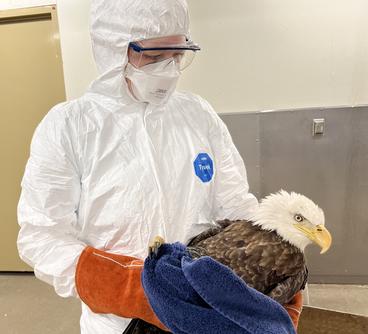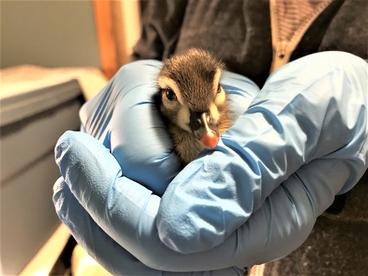The issue
Avian influenza is caused by a virus that has several strains, some of which are more dangerous than others. Avian Influenza (AI) is normally found in migratory waterfowl (swans, geese, ducks, etc). These birds can carry AI without getting sick. As they migrate, they spread the disease to other bird species as well as within their own colony.
The current strain being transmitted is a highly pathogenic form of the H5N1 strain, which has global agriculture trade impacts for the United States and can have severe impacts on susceptible birds of many species. While waterfowl can carry and shed this virus without any symptoms, birds like domestic chickens and raptors get severe illness and rapidly die. Highly Pathogenic Avian Influenza is spread in the feces and respiratory secretions of infected birds and can be easily transmitted on objects contaminated with virus particles. The virus is tough and can survive cold and freezing temperatures, as well as survive in aquatic environments.

What TRC is doing
Beyond putting together our resource page and webinar for those working with wildlife and birds, we're also closely monitoring our local wildlife populations for positive cases of avian influenza, and working with other organizations to better understand the current outbreak and help guide the response.
More on our recommendation for bird feeders
Click here to read more about HPAI and bird feeders
The Raptor Center now believes the risk of HPAI is low enough that bird feeders can be put out. However, our previous recommendations were to take down bird feeders during the height of the HPAI outbreak - to understand why, read our previous recommendations from March 2022:
The United States is unfortunately experiencing an unprecedented outbreak of highly pathogenic avian influenza (HPAI or H5N1) in our wild birds. It is important to remember that all bird species are susceptible to HPAI but how they show or do not show signs of illness and the role they play in carrying and spreading the disease will vary. This virus is shed in the feces and respiratory secretions of infected birds and is very hardy, with virus particles able to survive for weeks in cool, damp environments.
In wildlife, we know the most about how this virus works and presents in waterfowl, shorebirds, seabirds as these are the groups of birds who are most likely to carry and shed the virus without showing signs of illness.
We know some about how this virus impacts groups of birds like raptors, as these birds often get severely sick and rapidly die from the virus.
Unfortunately, we have a lot of gaps in knowledge about the role of songbirds in HPAI outbreaks. We have some data from previous outbreaks around the world, but this outbreak is very different. The 2022 outbreak is unique because of the very high levels of transmission of the currently circulating H5N1 virus strain in wildlife. With minimal viral surveillance being done with songbirds, it is hard to measure the risk of transmission from songbirds to other birds.
Every day at The Raptor Center, we are seeing the impact of HPAI as we triage and test birds like bald eagles and great horned owls that are intensely suffering from fatal neurological illness due to HPAI. With these infected birds, humane euthanasia is the only tool we have left to help them. We also know that this strain and outbreak is causing severe illness in other species like geese, ducks, blue jays, and crows.
During this serious bird flu outbreak, we recommend doing anything that we can to try and help our wild bird populations. Because the science is unclear on the role of songbirds in this current H5N1 outbreak, one consideration is to not encourage birds to gather together at places such as bird feeders or bird baths. These are places where things like viruses could easily be exchanged between individuals.
In areas with HPAI transmission in any avian species, consider pausing the use of bird feeders and baths for the next couple of months until the rate of virus transmission in wild birds dramatically decreases. Not only will this action help to protect those beautiful feathered creatures that visit your yard, but will also help all wild bird species that are already having a hard spring because of HPAI. We have it in our power to take a short term action so we are not accidentally assisting in the virus’ spread. This outbreak won’t last forever and I, for one, am greatly looking forward to when I can safely hang my bird feeders back up!
Dr. Victoria Hall, DVM, MS, DACVPM
